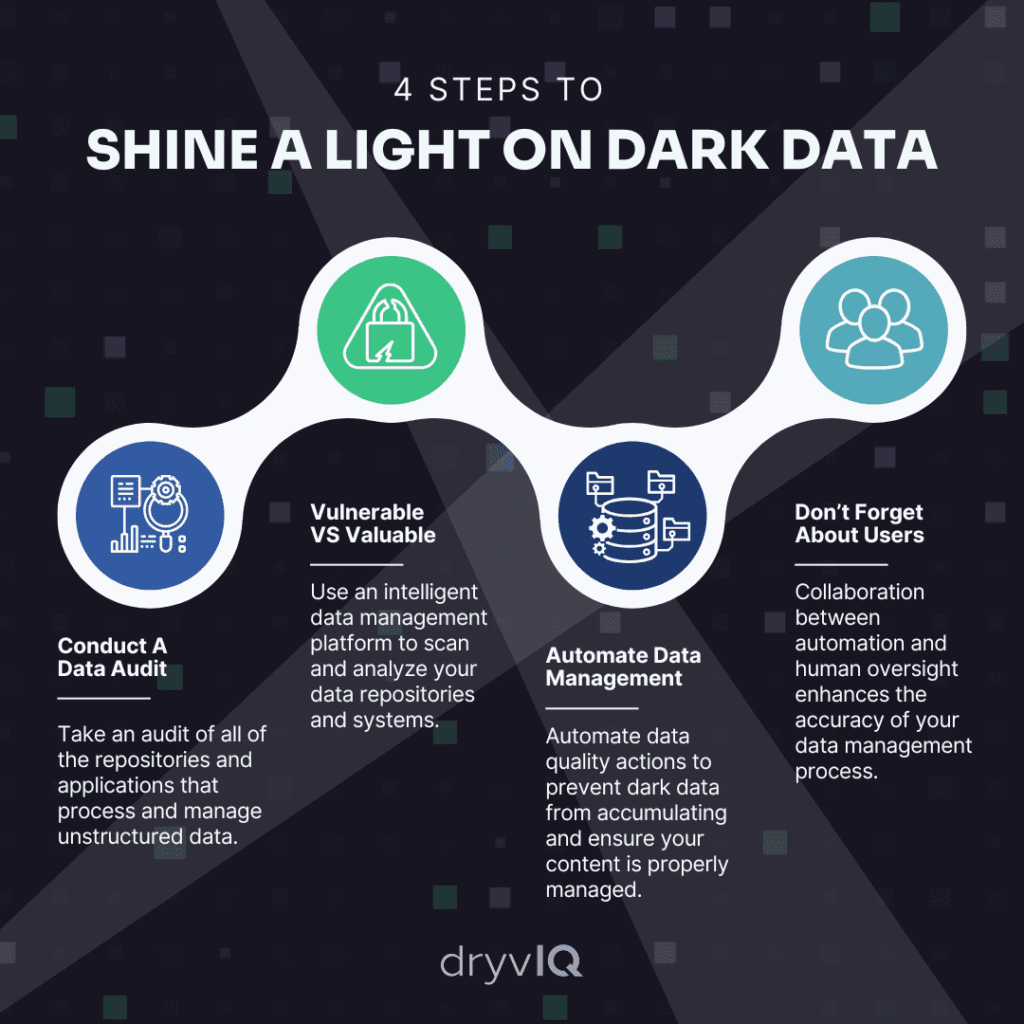Dark data is no secret; we’ve been talking about it for years. More than half of IT professionals and executives agree that dark data is a pressing concern, leaving business value on the table and creating vulnerabilities in data protection initiatives. And yet, even as we become more focused on data-driven strategies, dark data persists, hampering our digital transformation efforts. Why? Because the same transformative applications and platforms designed to streamline processes and improve efficiency often leave behind a trail of dark data of their own. It’s time to uncover this dark data and bring it into the light.

Illuminating The Impact Of Dark Data
The statistics on dark data are eye-opening:
- Fifty-five percent of an organization’s data is dark—untapped and unknown.
- Fifty-three percent of C-Level & IT professionals say dark data is a pressing concern, potentially opening up the company to vulnerabilities, risks and legal issues stemming from data breaches.
- Forty-eight percent of companies feel that they do not have the tech tools they need to manage and protect their dark data adequately.
When I talk to enterprise organizations and partners looking to solve this dark data problem, I’m consistently surprised by the growing number of repositories and line-of-business (LOB) applications each organization relies on daily—each comprised of mounds of data.
In fact, the average enterprise has a SaaS portfolio of nearly 500 applications. As IT environments expand, these systems become disconnected and siloed, and many of them are overlooked by traditional data discovery and classification platforms. Dark data continues to grow where we aren’t looking, creating hidden risks and impeding business transformation initiatives.

Unknown Data Grows in Unexpected Places
Consider e-signature solutions like Docusign or Adobe Acrobat Sign. These platforms have transformed the contract signing process and are now used daily for legal agreements, including NDAs, SOWs, financial disclosures, employment contracts, healthcare agreements and other important documents. Often, these types of platforms process and manage some of an organization’s most sensitive—and vulnerable—information.
And while these platforms streamline business operations, they can also generate significant amounts of dark data. Stop and ask yourself: Which contracts have you signed that are stored in these platforms? What sensitive information do they contain? Who has access to the agreements once they’re signed? How vulnerable are they?
Contracts and agreements are updated, modified, signed and stored, often without proper categorization or visibility. This data accumulates, turning into a digital black hole where valuable and potentially sensitive information is hidden from view.
Consider how many applications your knowledge workers use to conduct business and how many contribute to your dark data problem. There are more than you think.

How to Uncover and Shine a Light on Your Dark Data
To bring dark data out of the shadows, a proactive approach is no longer a nice-to-have; it’s imperative to overcoming data blind spots, ultimately enhancing data security and compliance. Here are actionable steps every company can consistently do to identify, organize and secure their dark data.
- Conduct A Data Audit: Take an audit of all of the repositories and line-of-business applications that process and manage unstructured data within your organization. This includes on-premises storage, cloud-based repositories and line-of-business systems, like e-signature applications. Don’t assume that IT is aware of every system being used; check in with business units to ensure you’re not missing any key platforms, like generative AI tools or other productivity-enhancing applications.
- Know What’s Vulnerable And What’s Valuable: Use an intelligent data management platform to scan and analyze your data repositories and systems. Once dark data has been discovered, automatically organize it based on its file type, sensitivity, usage and business value. These AI-powered platforms can uncover hidden patterns and insights, giving you the ability to sort through what’s vulnerable and what’s valuable to the organization, enabling better decision-making.
- Intelligently Automate Data Management: Beyond focusing solely on discovering dark data, the next step is to continually automate data quality actions to prevent dark data from accumulating and ensure your content is appropriately managed throughout its entire lifecycle. For example, once your documents have completed their lifecycle in a redundant location, such as an e-signature platform, they should be automatically moved to their defined location, typically a secure document management system. As content is constantly being created, modified and moved, continuous automation is essential.
- Don’t Forget About Users In Your Data Management Practices: Data management is not a “set it and forget it” task. It requires continuous attention and active involvement to maintain data quality and accuracy. While automation is critical for streamlining processes, your users’ participation is vital in content disposition. For example, once a contract is signed, automated processes can define the final action, such as archiving or transferring the document to its appropriate location, with your users validating that the action is correct when needed. This collaboration between automation and human oversight enhances the accuracy of your data management process and ensures the highest data quality.

Don’t Let Dark Data Dim The Impact Of Digital Transformation
The data we know about can be overwhelming, and the thought of the unknown—dark data—can be debilitating. But remember, knowledge is power. By confronting the problem and understanding where your data is accumulating and how users are interacting with it, you can enhance your data security, ensure compliance and support data-driven innovation. After all, you know you have dark data lurking around. And guess what?
Bad actors know it, too, and they’re looking for opportunities where you might not be. Find that dark data, protect it and turn it into an asset. If managed appropriately, dark data can propel your organization toward greater agility, efficiency and success.
This article was originally published with Forbes Tech Councils.
4 Steps to Shine a Light on Your Dark Data Infographic


